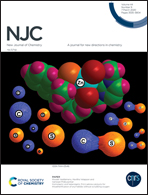Controllable synthesis of peapod-like TiO2@GO@C electrospun nanofiber membranes with enhanced mechanical properties and photocatalytic degradation abilities towards methylene blue†
Abstract
We prepared peapod-like titanium dioxide@graphene@carbon (TiO2@GO@C) nanofiber membranes through electrospinning. Due to the porous structure, large surface area, abundant surface functional groups and excellent thermal conductivity, GO can capsulize TiO2 nanoparticles to form a pea-like TiO2@GO structure. Subsequently, TiO2@GO can be wrapped by the carbon nanofiber during an electrospinning process, forming peapod-like TiO2@GO@C nanofiber membranes. The existence of a peapod-like structure is beneficial for enhancing the crystallinity of TiO2, and preventing the phase transformation of TiO2 from anatase to rutile phase at the same time. Furthermore, on the basis of the excellent carrier transport property of GO, the peapod-like TiO2@GO@C structure could also improve the light absorption, reduce recombination of hole–electron pairs, and improve the carrier transport and finally photocatalytic degradation property of methylene blue. Besides, the pea-like TiO2@GO structure shows a dispersion strengthening effect in the carbon nanofibers, preventing the carbon nanofibers from fracture. In particular, by optimizing the heat treatment temperature and additional amount of GO, the peapod-like TiO2@GO@C nanofiber membranes with 0.3 wt% GO show an excellent photocatalytic degradation efficiency of 98.5% in 3 h, and a high strength of 356.07 cN per dtex.



 Please wait while we load your content...
Please wait while we load your content...